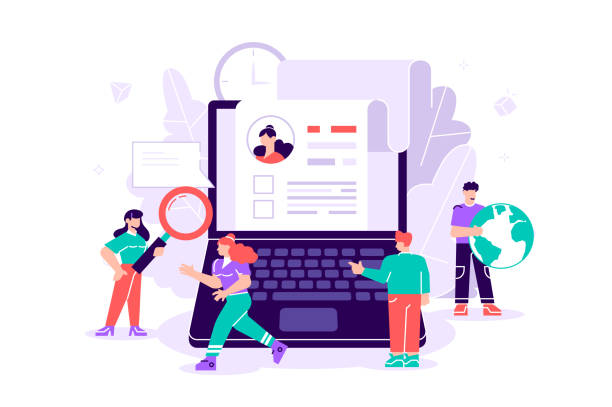Introduction to the Importance of Website Speed

In today’s digital world, website loading speed is not just a competitive advantage, but a vital necessity.
Internet users have high expectations, and even the slightest delay can lead to loss of visitors and ultimately customers.
The importance of #fast_website_design goes beyond merely providing a desirable user experience; it directly impacts your website’s #SEO_ranking.
Search engines like Google prioritize faster websites because they believe these websites offer a better user experience.
Imagine a user searching for a product or service who encounters a site that takes more than a few seconds to load; they will likely leave the page before the content fully displays and move on to your competitors.
This is where the importance of reducing Bounce Rate and increasing user dwell time on the site, both directly related to site speed, becomes clear.
A fast website not only keeps users satisfied but also significantly contributes to your business’s branding and credibility.
Studies show that even a one-second delay in loading can decrease conversion rates by up to 7%.
Consequently, investing in speed optimization for your website is a strategic decision for any business aiming for online success.
Does your company’s website create a professional and lasting first impression on potential customers? Rasaweb, with its professional corporate website design, not only represents your brand’s credibility but also opens a path for your business growth.
✅ Create a powerful and reliable brand image
✅ Attract target customers and increase sales
⚡ Get free consultation
Factors Affecting Website Slowdown
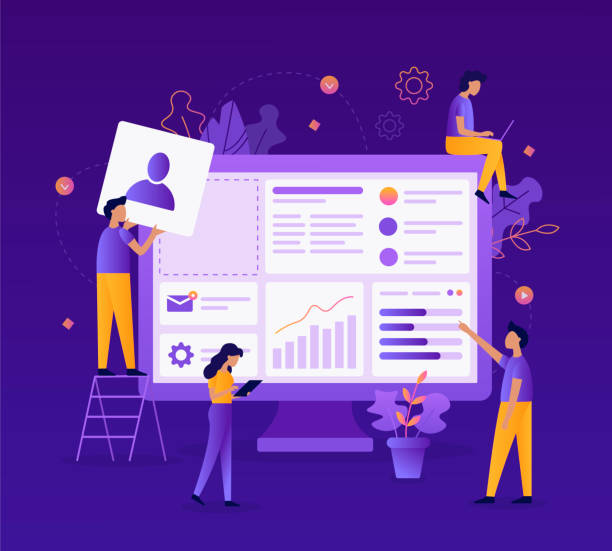
To achieve fast website design, one must first identify the root causes of website slowdown.
One of the most common reasons is #large_image_sizes and media files.
Images uploaded to the website without optimization and in large dimensions can severely reduce loading speed.
The next issue is #unoptimized_code and bulky code (such as CSS and JavaScript) that, without compression and minification, send many requests to the server and delay page rendering time.
Using too many unnecessary plugins and add-ons can also place a heavy load on the server and database, thereby reducing site speed.
Hosting quality also plays a crucial role; #inadequate_hosting or shared hosting with limited resources cannot handle website traffic and data processing.
Furthermore, not using caching and a Content Delivery Network (CDN) can cause the site content to be loaded from scratch every time, which is time-consuming.
Heavy web fonts and excessive use of JavaScript frameworks are other important factors.
Sometimes, database-related issues, such as inefficient queries or disorganized tables, can also significantly slow down website response time.
Understanding these factors is the first step towards implementing effective strategies for increasing website speed and improving user experience.
Choosing Suitable Hosting and CMS for Site Speed
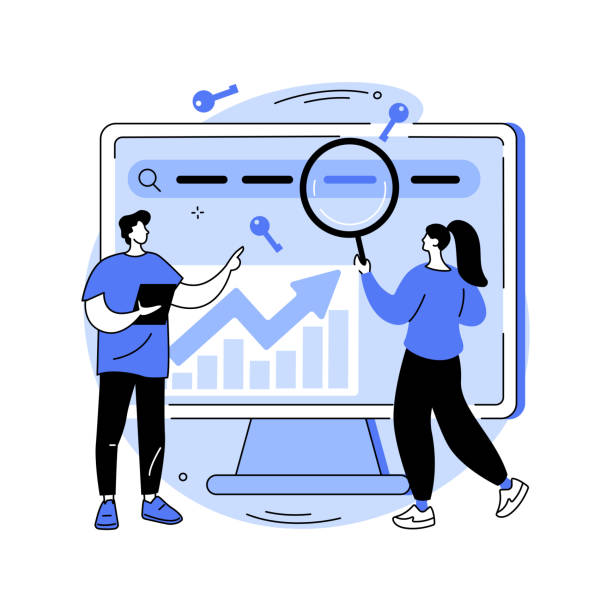
A large part of the #fast_website_design equation depends on selecting suitable infrastructures, namely #hosting and #Content_Management_System (CMS).
Hosting is like a home for your website, and if this home is weak or slow, no matter how optimized your website design is, you will still experience slow speeds.
Different types of hosting, such as shared hosting, dedicated hosting, VPS, and cloud hosting, each have their advantages and disadvantages.
For small and nascent websites, shared hosting might be sufficient, but for websites with high traffic or those that are growing, VPS or cloud hosting is highly recommended.
Cloud hosting is a very suitable option for high-speed websites due to its high scalability and load distribution.
When choosing a CMS, speed should also be considered.
Popular CMSs like WordPress, Joomla, or Drupal, each offer many features, but the method of optimization and the choice of themes and plugins play a key role in the final speed.
WordPress, due to its flexibility and large user community, is the choice of many developers, but without proper configuration and the use of caching plugins, it can become slow.
Lighter content management systems or custom-developed frameworks can offer more control over optimization but require more technical expertise.
Below is a table comparing some speed-related features in popular CMSs:
| CMS | Native Speed Optimization Capability | Number of Optimization Plugins | Complexity of Speed Settings |
|---|---|---|---|
| WordPress | Medium (requires plugins) | Very High | Medium |
| Joomla | Medium | High | Medium to High |
| Drupal | High | Medium | High |
| Magento | Medium (for large stores) | Medium | Very High |
Intelligent selection of hosting and CMS is the cornerstone of fast and efficient website design and should be done with care and sufficient study.
Optimizing Images and Media for Higher Speed
![]()
One of the most important and yet simplest steps for fast website design is #image_optimization and other media files.
Images constitute a large part of any website’s visual content, and if not managed correctly, they can become the biggest factor in site slowdown.
#Unoptimized_images with large dimensions and file sizes can severely increase page load time, which can significantly impact user experience.
To optimize images, you must first use suitable formats.
For photos, JPEG format is recommended, and for images with transparency or simple graphics, PNG.
Newer formats like WebP can also significantly reduce image file size while maintaining quality, making them very suitable for fast web design.
The next step is image compression.
Online tools and CMS plugins (such as Smush for WordPress) can reduce image file size without noticeable quality loss.
Also, resizing images to the actual dimensions they will be displayed on the website is very important.
For example, if you have an image with dimensions 2000×1500 pixels and it is to be displayed on the website at 500×375 pixels, you should resize it to 500×375 before uploading so that the browser does not have to resize it at load time.
In addition, using #Lazy_Load for images and videos, meaning they are only loaded when the user scrolls to the relevant section, can significantly improve initial page load speed.
Also, for videos, using external services like YouTube or Aparat instead of direct hosting on your own server is recommended to reduce the load on your server.
Implementing these recommendations is a fundamental step towards significantly increasing your website’s speed and enhancing user experience.
Does your current website represent your brand’s credibility as it should? Or does it scare away potential customers?
Rasaweb is your answer! With our specialized corporate website design services:
✅ Enhance your business’s credibility and standing
✅ Experience increased attraction of targeted leads and new customers
⚡ Contact Rasaweb now for a free corporate website design consultation!
Caching and CDN: Solutions for Increasing Speed

Two key concepts in website speed optimization and achieving fast website design are #Caching and #Content_Delivery_Network (CDN).
These two techniques work synergistically and can significantly reduce page load times.
Caching refers to the temporary storage of website data and files (such as HTML, CSS, JavaScript, images, etc.) in the user’s browser or on the server.
When a user visits your website for the first time, their browser downloads all the necessary files.
By enabling caching, on subsequent visits, the browser loads many of these files from its cache memory, eliminating the need to re-download from the server.
This significantly increases loading speed for returning visitors.
Types of caching include Browser Cache, Page Cache, Object Cache, and Database Cache, each playing a role in accelerating the loading process.
Using caching plugins like WP Super Cache or W3 Total Cache for WordPress makes implementing this feature easy.
Content Delivery Network (CDN) is a system of distributed servers located in various geographical points around the world.
When a user visits your website, the CDN delivers the static content of the website (such as images, CSS, JS) from the server closest to the user’s geographical location.
This reduces latency and increases data transfer speed, especially for users accessing your site from distant locations.
Using a CDN not only improves speed but can also enhance site security and offload traffic from your main server.
Services like Cloudflare, Akamai, and Google Cloud CDN are among the most popular options in this regard, which can effectively contribute to the process of high-speed website design.
The Role of Optimized Coding and Lightweight Frameworks

Fast website design is not limited to image optimization or caching; the quality of #website_coding also plays a very important role in the final speed.
Bulky, redundant, or unnecessary #CSS and #JavaScript code can significantly increase page load and rendering time.
A professional web developer understands the importance of clean, optimized, and minimalist code and tries to avoid code bloat as much as possible.
The first step in this regard is Minification and Concatenation of CSS and JavaScript files.
Minification involves removing extra spaces, comments, and unnecessary characters from the code, which reduces the file size.
Concatenation means combining multiple CSS files into one and multiple JavaScript files into one, which reduces the number of HTTP requests to the server and consequently increases loading speed.
In addition, the script loading order is also important.
It is best to load CSS files in the <head> section and JavaScript files at the end of the <body> section (using the defer or async attributes) to avoid delaying the rendering of the main page content.
Choosing #lightweight_frameworks is also important in this area.
While large frameworks like Bootstrap offer many features, they may contain extra code that is not used in your project.
Using lighter CSS and JS frameworks or even a CSS-in-JS approach can help reduce the final file size.
For custom projects, developers can write their code more carefully and avoid bloat.
Finally, regular code review and cleanup, eliminating dead code, and ensuring database query optimization all significantly contribute to achieving a high-performance and exceptionally fast website.
Website Speed Measurement Tools and Results Analysis
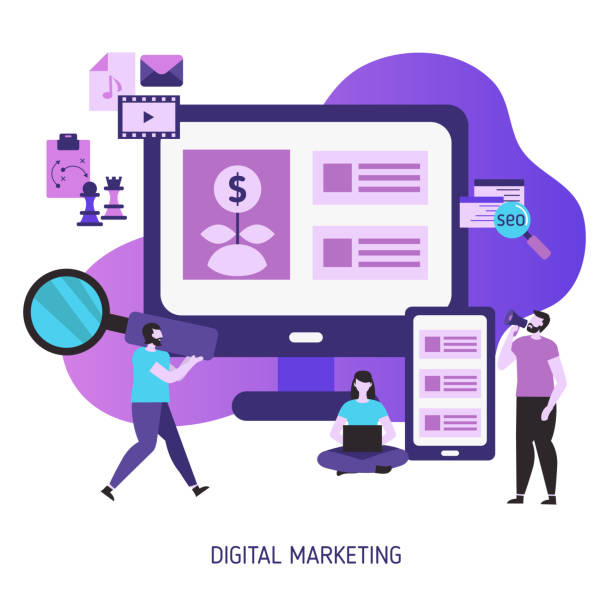
To know how fast your website is and what its weaknesses are, using #website_speed_measurement_tools is essential.
These tools provide various metrics to evaluate your website’s performance and help you identify bottlenecks and plan for faster website design.
One of the most well-known and widely used tools is Google PageSpeed Insights.
This tool provides a score from 0 to 100 for your website’s performance on both desktop and mobile, and offers suggestions for improvement.
Metrics such as #First_Contentful_Paint (FCP), #Largest_Contentful_Paint (LCP), and #Cumulative_Layout_Shift (CLS) are among the most important evaluated by this tool, which are part of Google’s #Core_Web_Vitals.
Other popular tools include GTmetrix and Pingdom Tools.
GTmetrix, in addition to a general score, displays complete details of loading waterfalls (Waterfall Charts), full page load time, number of requests, and total page size, which is very useful for detailed analysis.
Pingdom Tools also provides similar information and allows you to check your site’s speed from different locations around the world.
Analyzing the results of these tools is very important.
Don’t just rely on the score; pay attention to the #provided_suggestions and #detailed_reports.
Each suggestion is an opportunity for improvement.
For example, if the tool suggests optimizing images or compressing code, you should immediately take the necessary actions.
A fast website design requires continuous monitoring and ongoing optimization.
Below is a table of some of these tools and their key features:
| Tool | Main Focus | Key Reports | User Interface |
|---|---|---|---|
| Google PageSpeed Insights | Core Web Vitals, SEO | FCP, LCP, CLS, TBT | Simple, suggestion-based |
| GTmetrix | Overall performance, waterfall | Waterfall Chart, Page Speed, YSlow Scores | Comprehensive, high detail |
| Pingdom Tools | Load time, page size | Load Time, Page Size, Request Count | Simple, graphical display |
Regular use of these tools and following their suggestions is an essential approach to continuously maintain and improve your site’s speed, ensuring that your website is always at peak performance.
Is Fast Website Design Always Cost-Effective? Challenges and Costs
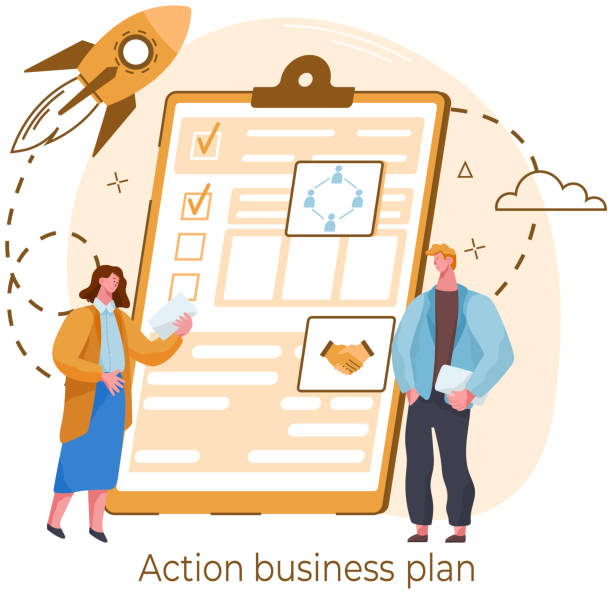
A crucial question in the field of #fast_website_design is whether this optimization is always economically viable. The answer is complex and depends on multiple factors.
Increasing website speed up to a certain point yields a very high return on investment, but beyond that, costs may increase rapidly, and the benefits may not be proportional.
One of the main challenges is infrastructure costs.
Upgrading hosting to more powerful servers or using advanced CDNs requires initial investment and monthly maintenance costs.
These costs can vary depending on traffic volume and website needs.
Another challenge is #skilled_personnel.
Optimizing code, databases, and server configuration requires deep technical knowledge and experience.
Hiring specialized developers or SEO consultants who are experts in website speed can be costly.
Also, ongoing maintenance and continuous optimization require time and resources.
Compatibility with new technologies is also a challenge.
New standards for website speed are constantly introduced (such as Google’s Core Web Vitals) that require updates and changes in the site’s structure.
These changes can be time-consuming and complex.
However, neglecting speed can also lead to many hidden costs.
Losing customers due to poor user experience, lower search rankings, and reduced conversion rates all mean #financial_loss for the business.
Therefore, the goal should be to find a balance between the costs of optimization and the benefits derived from it.
For many businesses, optimizing speed to outpace competitors and provide a desirable user experience is a smart investment with high returns.
Fast website design that focuses on user needs and business goals is often cost-effective, even if it requires initial investment.
Losing potential customers due to an unprofessional website? Rasaweb is your answer! With our specialized corporate website design services:
✅ Enhance your business’s credibility and position
✅ Experience the attraction of more targeted customers
⚡ Act now for a free consultation!
New Trends in Fast Website Design and User Experience

The world of web is constantly evolving, and with it, new trends in #fast_website_design and #user_experience (UX) emerge.
For your website to remain #optimized and competitive, you need to be familiar with these developments.
One of the most important recent trends is Google’s focus on Core Web Vitals, which includes metrics such as Largest Contentful Paint (LCP), Cumulative Layout Shift (CLS), and First Input Delay (FID).
These metrics go beyond just load time, addressing the actual user experience during interaction with the page, linking fast website design to highly responsive and visually stable website design.
Another rapidly growing trend is #Mobile-First_Design.
Given the significant increase in mobile device usage for internet access, websites must first be designed and optimized for mobile.
This approach not only helps with mobile loading speed but also ensures a flawless user experience on smaller screens.
Progressive Web Apps (PWAs) are also among the leading trends.
PWAs are websites that bring mobile application capabilities (such as offline work, push notifications, and access via an icon on the home screen) to the web.
This technology can significantly improve speed and stability and elevate the user experience to a new level.
Also, the use of technologies such as WebAssembly for executing high-performance code and Server-Side Rendering (SSR) or #Static_Site_Generation (SSG) to reduce Time To First Byte (TTFB) is expanding.
These approaches can especially help complex and content-rich websites achieve outstanding performance.
The future of web design is towards websites that not only load quickly but also provide an overall smooth and enjoyable user experience, even in poor network conditions.
Conclusion and Next Steps for Maintaining Website Speed
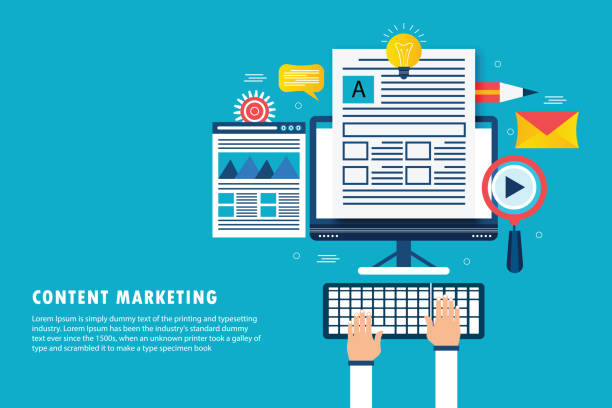
In this article, we discussed in detail the importance of #fast_website_design and the various factors influencing website speed.
From choosing #suitable_hosting and #CMS to optimizing images, using caching and CDN, and the vital role of optimized coding and speed measurement tools, each individually and collectively paves the way for achieving a high-speed website.
#Website_speed is no longer a luxury option but a critical factor for SEO success, increasing conversion rates, and providing a superior user experience.
To maintain and continuously improve website speed, you must adopt a #continuous and #systematic approach.
This is not achieved by a one-time initial optimization but requires regular monitoring and applying updates.
Your next steps to ensure your website remains optimized and fast include the following:
- Regular speed monitoring: Periodically check your site’s speed using tools like Google PageSpeed Insights, GTmetrix, and Pingdom Tools.
- Updates and maintenance: Ensure your CMS, themes, and plugins are always updated to the latest version.
This not only helps with security but also brings performance improvements. - Regular database cleanup: Removing unnecessary information and optimizing database tables can increase response speed.
- Content review and optimization: Remove or optimize old and unnecessary content.
Also, don’t forget continuous optimization of images and videos. - Education and awareness: Keep yourself and your team updated with the latest speed optimization trends and new technologies.
Knowledge and awareness are key to maintaining competitiveness in the web space.
By adhering to these principles and consistently paying attention to details, you can ensure that your website not only has a fast website design today but will also maintain this advantage in the future, providing an unparalleled experience for your users.
Frequently Asked Questions
| Question | Answer |
|---|---|
| What is fast website design? | It refers to the process of building and launching a website in a short period, usually using ready-made platforms or optimized methods. |
| Why is speed important in website design? | High speed improves user experience, increases SEO ranking, and boosts the conversion rate of visitors into customers. |
| What tools are available for fast website design? | Content Management Systems (CMS) like WordPress, Joomla, and Drupal, drag-and-drop website builders, and fast web development frameworks. |
| What are the benefits of using a CMS for fast design? | Ready-made templates, diverse plugins, easy content management without extensive coding, and a large user community for support. |
| Does fast website design mean low quality? | Not necessarily. By using appropriate tools and methods, a high-quality website can also be designed quickly. |
| What factors affect website design speed? | Project complexity, designer’s experience, choice of platform or tool, content and image readiness, and effective communication with the client. |
| How is responsive design considered in fast website design? | Most fast design templates and tools are responsive by default and require little to no configuration. |
| How much does fast website design cost? | The cost varies depending on complexity, chosen platform, and additional services, but it is usually less than custom design from scratch. |
| How can the loading speed of a designed site be increased? | Image optimization, browser caching, file compression, using CDN, and choosing suitable hosting. |
| When is fast website design a suitable option? | For small businesses, startups, personal websites, or projects that require quick launch and have limited budgets. |
And other advertising services by Rasaweb Advertising Agency
Smart Data Analysis: A fast and efficient solution for improving SEO ranking with a focus on intelligent data analysis.
Smart Marketing Automation: An innovative service for increasing click-through rates through attractive UI design.
Smart Social Media: A creative platform for improving SEO ranking by optimizing key pages.
Smart Website Development: Revolutionize sales growth with the help of user experience customization.
Smart UI/UX: A creative platform for improving SEO ranking with user experience customization.
And over a hundred other services in internet advertising, advertising consultation, and organizational solutions
Internet Advertising | Advertising Strategy | Advertorials
Sources
Fast Website Design Guide
Optimizing Web Performance
SEO-Oriented Website Design
Comprehensive Web Design Tips
? For your business’s leap in the digital world, Rasaweb Digital Marketing Agency, with years of experience in providing services such as e-commerce website design, SEO, and online advertising, paves your path to success.
📍 Tehran, Mirdamad Street, next to Bank Markazi, Kazeroon Jonubi Alley, Ramin Alley, Plaque 6

